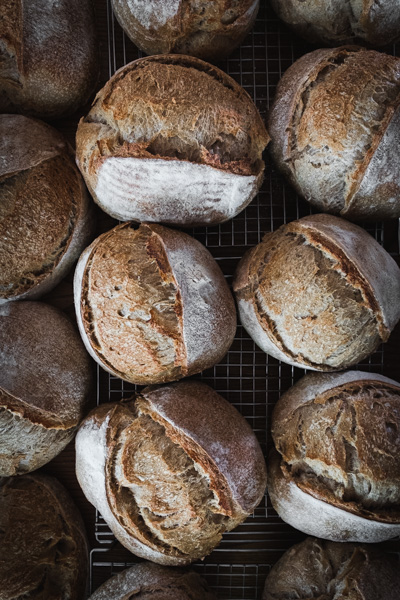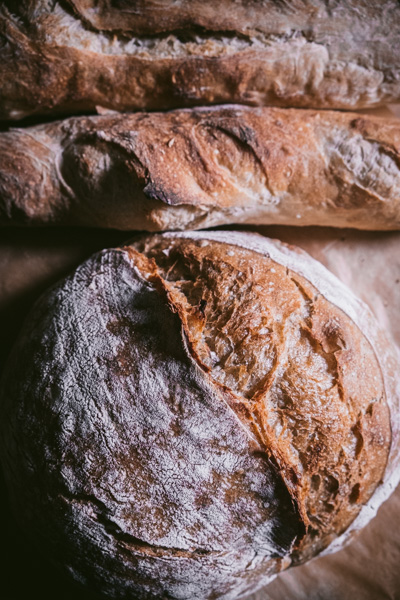
Flat Loaf. Unhappy Baker.
Hi all!
I'm Bekah, and I've been lurking in the shadows for quite some time here now and finally decided it was time I join in the conversation. I've so enjoyed learning on this forum! First things first, I'm a food photographer, blogger and micro-baker (https://www.instagram.com/theedgewoodbaker/). I primarily bake artisan breads and from-scratch pastries which I sell at my local farmer's market as well as for clients. I ventured into sourdough about 4 months ago although my husband has been dabbling in it for over a year. I would say that my skill level is competent but not consistent. I've had great bakes and flop bakes.
Recently since the temperatures have risen here (90F+), I've really been struggling with just my basic sourdough recipe and hoping you can help me troubleshoot. My issue is that my sourdough is getting little oven spring and no defined score - in a nutshell, flat. I'm going to walk you through my most recent bake and see if you can help me identify issues.
- Starter refresh - I keep mine in the fridge (never more than 3-4 days at a time) but always feed twice before a bake and add my starter right at or before peak. For this bake, I fed the night before and the morning of - 90% bread flour, 10% rye flour and 100% hydration. I did 100% hydration for this bake as I wanted it to peak sooner, but given the heat, I've typically been doing 80% to keep it a little stiffer and slower.
- Basic recipe: 400g flour (380g bread, 20g whole wheat), 280g cold water (70%), 100g levain, 10g salt
- Mixed flour and water for autolyse at 10:10am - I normally do 75% but given the humidity, reduced to 70%. (Temp at autolyse 75.7F)
- Added levain at 3:20 - rubaud mixing for 3 minutes. (Long autolyse...I know. Could this be contributing to the flatness?)
- Added salt at 3:35 - mixed for a couple more minutes. Transferred to clean dish. Temp = 74.8F
- S+F at 4:07 (30 min later). Temp = 73.2. Losing temp so put in oven with light on.
- Coil Fold at 4:37 (30 min later). Temp = same. Moved closer to oven light.
- Coil Fold at 5:11 (30 min later). Temp = 75. Visible signs of fermentation. Small bubbles on top. Not as many as I'm typically used to seeing so let ferment for another hour before preshape.
- Pre-shape at 6:10.
- Shape, place in banneton then fridge at 6:25.
- Total bulk ferment from levain add to fridge right around 3 hours.
- Cold proof in fridge - 13.5 hours
- Baked at 8am next morning. One score down the right side (with the hope to create an ear). Spritzed with water. Preheated 475F oven in a challenger breadpan for 20 minutes, covered. Then 20 minutes uncovered.


As you can see the loaf is flat which I've read is a sign of overproving and thus the gluten structure breaking down. There's also a big dip in the right side. However, I look at my crumb and still think it looks a little bit tight so maybe it's underproved? I know shaping can also be a culprit, but I'm pretty confident in my ability to shape. Before the temps were so high, these were my normal bakes...


So what thoughts do you have? What would you tweak/change to avoid such a flat loaf? Looking forward to hearing!


So glad you decided to join TFL. As you put it, first things first: your Instagram photos are superb! You clearly have good mastery of both camera and kitchen! As an amateur photographer that cannot come close (yet) to the quality of your photos, and as an amateur baker that cannot come close (yet!) to the quality of your baking, I feel like I am "carrying coal to Newcastle" as the saying goes. But, you asked for opinions, and here they are always free, hence, worth fully what you pay for them. :)
Thoughts: at first blush I'd say over-proofed, but not by much. I think the crust shows it more in this case than the crumb, but your mention of the high temperatures is really the tip-off.
I see that your bulk fermentation was completed in the oven with the light on. At the 4:37 point you had steady temperature, and moved the dough closer to the light. From there you gained 1.8 degrees in just 30 minutes, but did not mention another temperature reading after that, although BF continued for another hour. Perhaps you have it in your impeccable notes? I'm suspicious that you continued to gain temperature in your dough past the 75F at the last mentioned check, and that the dough went into the fridge a bit, perhaps quite a bit, warmer than you thought. This would also have given you more fermentation during the rest of the BF, and it would have taken some time to cool the shaped loaves down to stop fermentation once into the fridge. Allowing the fermentation to continue on deeper into the retard time would be reflected in slightly over-proved loaves when you went to bake them.
You did not mention if you benched the loaves in the morning for any time, or baked straight out of the fridge. Given the rest of your process, and again deferring to your excellent notes, I'm figuring not. How did you find the loaves when you scored them? Did the loaves sit a bit low and flat on the peel when you set them for scoring? Did they pull a bit more than usual when you did the scoring? I find that over-proofing always makes scoring harder than otherwise at the same hydration. I'm guessing maybe so on both counts, just a little bit perhaps, and perhaps a little more than that even.
So, slightly or just more than slightly over-proofed because of a higher than usual dough temperature going into retarding, as a result of higher dough temperature out of bulk fermentation, all as a result of the warmer than usual weather. It gets me every time I must admit, until the first such bake reminds me to watch everything closer, and to expect everything to move faster.
Well, you asked! I hope it is not all complete rubbish. :) And, welcome, again, to The Fresh Loaf! I look forward to seeing more of your baking here.
OldWoodenSpoon
Thank you for your kind comments. After my last coil fold, I did not do another temp check prior to pre-shaping. I have my two little kiddos to thank for missing that. But I think you're quite right. By the time it was pre-shaped, bench rested and shaped for the fridge, it could have been overproved based on the last temp reading of 75.
I did not bench the loaves in the morning for any time. I typically always bake straight out of the fridge. As for scoring, I did notice the loaf sitting a bit low and flat as you mention although it didn't pull greatly with I scored it. Just ever so slightly. Your comments are extremely helpful. Thanks for taking the time to read my novel of a post!
That crumb looks excellent!
things:
In my observation, since the "isolation bakers" started coming here for diagnosis/help, the number one cause of loaves not coming out as intended is that the baker changed something while assuming that their change was "equivalent" to what the recipe called for, or whatever their previous ingredient/procedure was.
So... was there anything else besides the ambient temp and length of autolyse changed from the "before" loaves to the "after" loaf? Baking/oven/vessel setup? Brand of flour? Final proof method? Banneton? Spritzing water on the loaf? Steaming the oven?
Thanks for weighing in! I treated this loaf differently than the "good" loaves pre-bake in that I spritzed with water and used less flour in my banneton than usual. I've been working to get a bit more color on my crust which is why I elected to go that route this time around. Outside of that, oven was the same although I did use a challenger breadpan instead of a dutch oven, but I'd imagine they don't vary too much in the way they bake. I hadn't thought about the autolyse effects on turning the starch into sugar and find that really insightful. Those kinds of details are still where I have quite a lot to learn. Thanks for your input!
"in that I spritzed with water and used less flour in my banneton than usual. "
One of the purposes of flour in the banneton, and either a cloth liner or a porous (rattan, etc) banneton, is to "wick away" moisture from the loaf and create a skin, or rather to dry out the gluten cloak/skin that is formed by shaping. if the skin doesn't dry a bit, it won't be firm enough to get a clean score, and won't be strong enough to force expansion along the score line and thereby create the "bloom".
So, continue to generously flour the bannetons, but then brush the flour off with a pastry brush if you want less white tops.
the overall hydration in the loaf and the shaping also play a part in how the skin dries.
In order to get the darker crust and "blisters" some people do add a bit of water, but they do so by first brushing off the flour and then brushing on the water. see a video on the Northwest Sourdough channel on youtube by Teresa Greenway.
"although I did use a challenger breadpan instead of a dutch oven, but I'd imagine they don't vary too much in the way they bake."
That is a great pan! I've seen videos of the challenger pan.
Yet, It is different enough to make a difference. The top is massive and shaped differently. It will start cooking the upper crust via radiant heat much faster than a regular dutch oven. So my suggestion would be to only preheat it to 20 degrees F above the initial cooking temp, not the 50 degrees that is often recommended for dutch ovens.
Secondly, I believe it has a better seal than most dutch ovens. so it is going to hold in moisture better, possibly exacerbating the excess moisture created with the spritz. so just use a quick fine spritz, or better, brush on the water, using as little as possible.
Great points. I didn't think of the effect of the flour in helping to dry out the gluten skin. Thus my lack of flouring and my generous spritz of water both contributed to my score "flop". I will check out the video you recommended.
You're quite right. I did see the seal on the challenger bread pan being significantly different than a dutch oven. I normally bake my loaves at 500F for 15 minutes before dropping the temperature, but for this bake I did 475. However, that is purely coincidental and not because I was cognizant of the differences in how the challenger breadpan works. :)
I think the larger take-away here is that I'm underestimating the impact of small changes, assuming they will have little or no impact when the opposite is true, and combined together in one bake, is creating my less-than-desirable results. So much insight. Thank you.
I went looking for the Northwest Sourdough video that I remembered. Either she made it private, or deleted it.
What I did find was a "blister" playlist. In #5, she brushes off the flour, but then generously spritzes, then bakes on a stone with an inverted roaster pan to cover it.
So apparently there is little/no benefit to brushing on water, over spritzing.
And you're good to conclude that a sequence of small changes added up.
One time I baked 4 baguettes. The ones that I spritzed with water came out flatter than the ones I left alone. Don't know why, but just thought I would tell you that.
Welcome to the group! I have just a couple of comments to add to what has already been mentioned.
That seems to be an exceptionally long autolyse, especially for a mostly white flour dough, so you might try reducing that to a couple of hours max.
Also, you don't really mention too many details to say that your dough was done bulk fermenting, like it had risen 30-50%. The BF time may be possibly too short...always best to go by what the dough is telling you rather than following a strict timetable. Where the dough meets the bowl should be slightly domed and the dough should have some larger bubbles and be somewhat light and jiggly (when you shake the bowl slightly). Then it is ready to be shaped.
Shaping issues can also negatively impact your final result. Sometimes, when bakers make the switch from commercial yeast to sourdough, they still 'knock back' the dough before shaping, which doesn't really work well for sourdough. Naturally fermented dough (if you are wanting a more open crumb) should be handled gently.
Finally, you seem to be using a rather high percentage of starter for your dough, at 25%, so the long cold proof might be too long. Typically, recipes with a higher percentage of starter benefit from a quicker start to finish, whereas smaller amounts typically are utilized with a longer process.
You might something helpful here as well:
http://www.thefreshloaf.com/node/59319/how-long-too-long-autolyse-stage
I'm sure you will be able to tweak here and there and end up where you want! Good luck with everything!
Yes, you're quite right. It was an exceptionally long autolyse. I'll be reducing that next time. As for bulk fermentation, I didn't mention overall rise which is most definitely something I look for. I would say by the time I pre-shaped, it had risen at least 30%, but I didn't notice larger bubbles (as I have in the past). It felt somewhat light and jiggly but again, not as much as other loaves I've shaped. Judging bulk fermentation beyond timetables is something I'm still working on and is quite honestly the most difficult part of sourdough baking for me so far.
I typically always have a long, cold proof so your comment on the percentage of starter is helpful. I'll try reducing that next time and see what results I get. Thanks again!